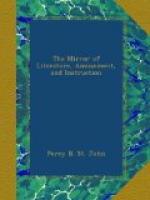* * * * *
CIRCULAR TEMPLES.
(For the Mirror.)
These structures are generally supposed to have been built with astronomical allusions, especially the noble temple at Stonehenge. Circular temples existed among the Israelites. In Exodus, c. xxiv. v. 4, it is written that “Moses rose up early in the morning, and builded an altar under the hill, and twelve pillars.” Again in Joshua, iv. 9, Joshua set up twelve stones; and it is well worthy of remark, that the twelve pillars of Moses and Joshua correspond with the number of stones of the inner circles at Abury. It is possible that these stones were plastered over, and probably highly ornamented, as in Deuteronomy, xxvii. 2, we read, “Thou shalt set thee up great stones, and plaster them with plaster;” and there is a large, upright stone in Ireland, which, according to the legend of the country, was once covered over with gold. On some of these pillars it is likewise probable that certain characters were traced, as among the Israelites words of the law were written upon similar obelisks or columns.
The earliest temples in Greece were formed of obeliscal columns; and in some parts of Africa the custom obtains to this day. Hence the pillars of our present temples are the most ancient; and subsequent builders of holy sanctuaries filled up the intercolumniations till the temples were constructed as we now see their ruins in Athens and elsewhere. But many of the early temples were round; and it is a curious fact, hitherto unnoticed, I believe, that the altar end, the sanctum of our earliest Saxon churches, is circular.
JAMES SILVESTER.
* * * * *
ST. OLAVE.—A MANX LEGEND.
(For the Mirror.)
[Magnus, King of Norway, having committed sacrilege, by opening the grave of St. Olave, he was commanded by the spirit of the offended saint to perform the voluntary penance of quitting the kingdom in thirty days. He obeyed this intimation, and immediately left Norway. Having conquered many of the Western Isles, at length he established himself in the Isle of Man. Afterwards attempting the reduction of Ireland, he was surrounded by the natives and slain, with the whole of his followers.]
Olave, of rocky Norway’s saints,
the holiest and the best,
Entomb’d in tumulus, enjoys a calm
and peerless rest;
By all of heav’ns votaries in saintly
rank renown’d,
As high in blessedness, and chief in holy
missal crown’d.
The dead—in holy, stilly peace,
the sacred dead repose,
Afar from earth’s turmoil and grief,
and all of sick’ning woes;
From racking pain, and withering pride,
and avarice’s care,
Secure they rest in solitude, unaw’d
by sin or snare.
To sack the gloomy sepulchre of lately
living clay,
From cheerful day and life remov’d,
by dreaded death away,
Is crime indeed of blackest hue, deserving
exile’s fate,
From native climes ordain’d to feel
an outlaw’s dreary state.




